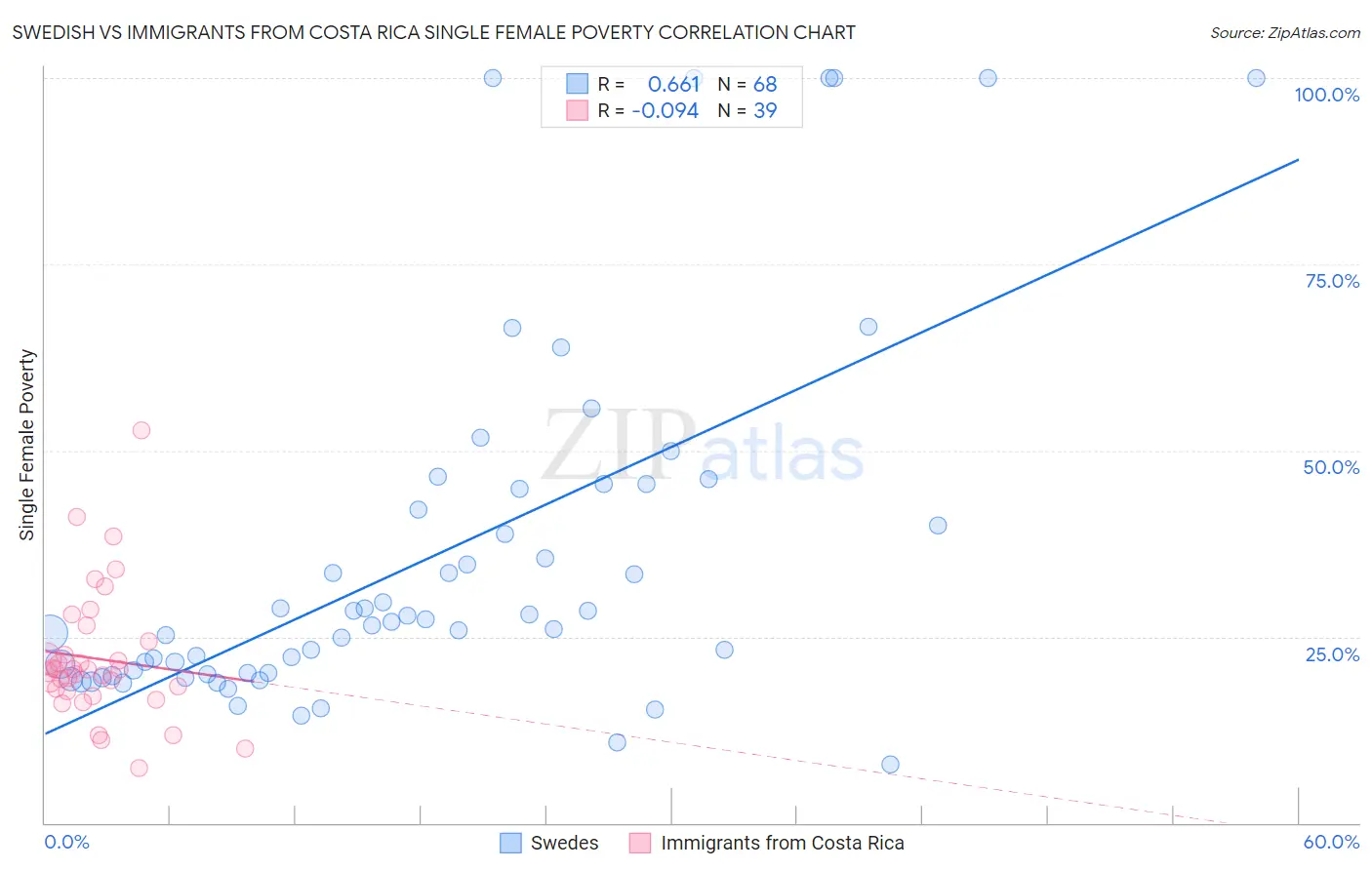Swedish vs Immigrants from Costa Rica Single Female Poverty
COMPARE
Swedish
Immigrants from Costa Rica
Single Female Poverty
Single Female Poverty Comparison
Swedes
Immigrants from Costa Rica
20.6%
SINGLE FEMALE POVERTY
77.1/ 100
METRIC RATING
153rd/ 347
METRIC RANK
20.9%
SINGLE FEMALE POVERTY
61.5/ 100
METRIC RATING
168th/ 347
METRIC RANK
Swedish vs Immigrants from Costa Rica Single Female Poverty Correlation Chart
The statistical analysis conducted on geographies consisting of 521,559,813 people shows a significant positive correlation between the proportion of Swedes and poverty level among single females in the United States with a correlation coefficient (R) of 0.661 and weighted average of 20.6%. Similarly, the statistical analysis conducted on geographies consisting of 202,952,607 people shows a slight negative correlation between the proportion of Immigrants from Costa Rica and poverty level among single females in the United States with a correlation coefficient (R) of -0.094 and weighted average of 20.9%, a difference of 1.2%.

Single Female Poverty Correlation Summary
| Measurement | Swedish | Immigrants from Costa Rica |
| Minimum | 7.9% | 7.4% |
| Maximum | 100.0% | 52.6% |
| Range | 92.1% | 45.2% |
| Mean | 35.5% | 22.0% |
| Median | 26.8% | 20.6% |
| Interquartile 25% (IQ1) | 20.1% | 17.6% |
| Interquartile 75% (IQ3) | 43.5% | 24.4% |
| Interquartile Range (IQR) | 23.4% | 6.8% |
| Standard Deviation (Sample) | 23.9% | 8.8% |
| Standard Deviation (Population) | 23.7% | 8.7% |
Demographics Similar to Swedes and Immigrants from Costa Rica by Single Female Poverty
In terms of single female poverty, the demographic groups most similar to Swedes are Immigrants from Western Europe (20.6%, a difference of 0.030%), Immigrants from Uruguay (20.6%, a difference of 0.050%), Samoan (20.6%, a difference of 0.10%), South American Indian (20.6%, a difference of 0.13%), and Puget Sound Salish (20.6%, a difference of 0.24%). Similarly, the demographic groups most similar to Immigrants from Costa Rica are Immigrants from Norway (20.8%, a difference of 0.090%), Norwegian (20.8%, a difference of 0.10%), Ugandan (20.8%, a difference of 0.16%), Iraqi (20.8%, a difference of 0.20%), and Immigrants from Trinidad and Tobago (20.9%, a difference of 0.34%).
| Demographics | Rating | Rank | Single Female Poverty |
| Immigrants | Denmark | 80.5 /100 | #150 | Excellent 20.5% |
| Puget Sound Salish | 79.6 /100 | #151 | Good 20.6% |
| Immigrants | Uruguay | 77.7 /100 | #152 | Good 20.6% |
| Swedes | 77.1 /100 | #153 | Good 20.6% |
| Immigrants | Western Europe | 76.7 /100 | #154 | Good 20.6% |
| Samoans | 76.0 /100 | #155 | Good 20.6% |
| South American Indians | 75.7 /100 | #156 | Good 20.6% |
| Immigrants | Oceania | 74.3 /100 | #157 | Good 20.7% |
| Danes | 73.0 /100 | #158 | Good 20.7% |
| Costa Ricans | 71.8 /100 | #159 | Good 20.7% |
| Arabs | 70.8 /100 | #160 | Good 20.7% |
| Kenyans | 68.5 /100 | #161 | Good 20.8% |
| Northern Europeans | 68.4 /100 | #162 | Good 20.8% |
| Lebanese | 67.6 /100 | #163 | Good 20.8% |
| Iraqis | 64.5 /100 | #164 | Good 20.8% |
| Ugandans | 64.0 /100 | #165 | Good 20.8% |
| Norwegians | 63.0 /100 | #166 | Good 20.8% |
| Immigrants | Norway | 63.0 /100 | #167 | Good 20.8% |
| Immigrants | Costa Rica | 61.5 /100 | #168 | Good 20.9% |
| Immigrants | Trinidad and Tobago | 56.3 /100 | #169 | Average 20.9% |
| New Zealanders | 53.2 /100 | #170 | Average 21.0% |